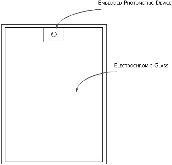Split-pane electrochromic window control based on an embedded photometric device with real-time daylighting computing
Abstract
Well-designed electrochromic (EC) glazing control can improve the energy performance of buildings and visual comfort of occupants in highly glazed buildings. Here in this paper, we designed and demonstrated a compact integrated EC glazing automation system to control tint states of a split-pane EC window according to variations of sky conditions. The control is based on monitoring the luminance distribution of the sky and real-time lighting computation for a building interior, using an embedded photometric device (EPD). It optimizes tint states of EC glazing to offer sufficient daylight provision and temper discomfort glare for occupants, which potentially mitigates excessive solar heat gain. ’In-situ’ experiments were conducted in a full-scale testbed to demonstrate the daylighting performance under various sky conditions. Finally, experimental results showed 83% of the working time for work-plane illuminance (WPI) and 95% of the time for daylight glare probability (DGP) were constrained in comfort range (WPIϵ[500, 2000] lux, DGP ≤ 0.35) by the automated EC glazing (controlled by EPD) under clear skies; 68% of the time for WPI and 94% of the time for DGP in confined range under clear skies with thin clouds; 62% of the time for WPI and 85% of the time for DGP inmore »
- Authors:
-
- École Polytechnique fédérale de Lausanne (EPFL), Lausanne (Switzerland)
- Lawrence Berkeley National Lab. (LBNL), Berkeley, CA (United States)
- Idiap Research Institute, Martigny (Switzerland)
- Publication Date:
- Research Org.:
- Lawrence Berkeley National Laboratory (LBNL), Berkeley, CA (United States)
- Sponsoring Org.:
- USDOE Office of Energy Efficiency and Renewable Energy (EERE), Energy Efficiency Office. Building Technologies Office
- OSTI Identifier:
- 1559240
- Alternate Identifier(s):
- OSTI ID: 1531189
- Grant/Contract Number:
- AC02-05CH11231
- Resource Type:
- Accepted Manuscript
- Journal Name:
- Building and Environment
- Additional Journal Information:
- Journal Volume: 161; Journal Issue: C; Journal ID: ISSN 0360-1323
- Publisher:
- Elsevier
- Country of Publication:
- United States
- Language:
- English
- Subject:
- 42 ENGINEERING; 32 ENERGY CONSERVATION, CONSUMPTION, AND UTILIZATION; 97 MATHEMATICS AND COMPUTING; Electrochromic window; Real-time lighting simulation; FPGA; Embedded photometric system; Visual comfort; HDR imaging
Citation Formats
Wu, Yujie, Wang, Taoning, Lee, Eleanor S., Kämpf, Jérôme H., and Scartezzini, Jean-Louis. Split-pane electrochromic window control based on an embedded photometric device with real-time daylighting computing. United States: N. p., 2019.
Web. doi:10.1016/j.buildenv.2019.106229.
Wu, Yujie, Wang, Taoning, Lee, Eleanor S., Kämpf, Jérôme H., & Scartezzini, Jean-Louis. Split-pane electrochromic window control based on an embedded photometric device with real-time daylighting computing. United States. https://doi.org/10.1016/j.buildenv.2019.106229
Wu, Yujie, Wang, Taoning, Lee, Eleanor S., Kämpf, Jérôme H., and Scartezzini, Jean-Louis. Thu .
"Split-pane electrochromic window control based on an embedded photometric device with real-time daylighting computing". United States. https://doi.org/10.1016/j.buildenv.2019.106229. https://www.osti.gov/servlets/purl/1559240.
@article{osti_1559240,
title = {Split-pane electrochromic window control based on an embedded photometric device with real-time daylighting computing},
author = {Wu, Yujie and Wang, Taoning and Lee, Eleanor S. and Kämpf, Jérôme H. and Scartezzini, Jean-Louis},
abstractNote = {Well-designed electrochromic (EC) glazing control can improve the energy performance of buildings and visual comfort of occupants in highly glazed buildings. Here in this paper, we designed and demonstrated a compact integrated EC glazing automation system to control tint states of a split-pane EC window according to variations of sky conditions. The control is based on monitoring the luminance distribution of the sky and real-time lighting computation for a building interior, using an embedded photometric device (EPD). It optimizes tint states of EC glazing to offer sufficient daylight provision and temper discomfort glare for occupants, which potentially mitigates excessive solar heat gain. ’In-situ’ experiments were conducted in a full-scale testbed to demonstrate the daylighting performance under various sky conditions. Finally, experimental results showed 83% of the working time for work-plane illuminance (WPI) and 95% of the time for daylight glare probability (DGP) were constrained in comfort range (WPIϵ[500, 2000] lux, DGP ≤ 0.35) by the automated EC glazing (controlled by EPD) under clear skies; 68% of the time for WPI and 94% of the time for DGP in confined range under clear skies with thin clouds; 62% of the time for WPI and 85% of the time for DGP in confined range under partly cloudy skies.},
doi = {10.1016/j.buildenv.2019.106229},
journal = {Building and Environment},
number = C,
volume = 161,
place = {United States},
year = {Thu Jun 27 00:00:00 EDT 2019},
month = {Thu Jun 27 00:00:00 EDT 2019}
}
Web of Science
Figures / Tables:
 Fig. 1: Design of an EC glazing integrated with an EPD (view from the outdoors towards the glazing surface)
Fig. 1: Design of an EC glazing integrated with an EPD (view from the outdoors towards the glazing surface)
Figures / Tables found in this record:

 Search WorldCat to find libraries that may hold this journal
Search WorldCat to find libraries that may hold this journal